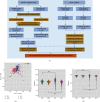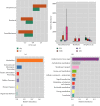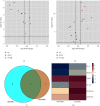Fecal Microbiota Underlying the Coexistence of Schizophrenia and Multiple Sclerosis in Chinese Patients
- PMID: 37680457
- PMCID: PMC10482522
- DOI: 10.1155/2023/5602401
Fecal Microbiota Underlying the Coexistence of Schizophrenia and Multiple Sclerosis in Chinese Patients
Abstract
Both schizophrenia (SZ) and multiple sclerosis (MS) affect millions of people worldwide and impose a great burden on society. Recent studies indicated that MS elevated the risk of SZ and vice versa, whereas the underlying pathological mechanisms are still obscure. Considering that fecal microbiota played a vital role in regulating brain functions, the fecal microbiota and serum cytokines from 90 SZ patients and 71 age-, gender-, and BMI-matched cognitively normal subjects (referred as SZC), 22 MS patients and 33 age-, gender-, and BMI-matched healthy subjects (referred as MSC) were analyzed. We found that both diseases demonstrated similar microbial diversity and shared three differential genera, including the down-regulated Faecalibacterium, Roseburia, and the up-regulated Streptococcus. Functional analysis indicated that the three genera were involved in pathways such as "carbohydrate metabolism" and "amino acid metabolism." Moreover, the variation patterns of serum cytokines associated with MS and SZ patients were a bit different. Among the six cytokines perturbed in both diseases, TNF-α increased, while IL-8 and MIP-1α decreased in both diseases. IL-1ra, PDGF-bb, and RANTES were downregulated in MS patients but upregulated in SZ patients. Association analyses showed that Faecalibacterium demonstrated extensive correlations with cytokines in both diseases. Most notably, Faecalibacterium correlated negatively with TNF-α. In other words, fecal microbiota such as Faecalibacterium may contribute to the coexistence of MS and SZ by regulating serum cytokines. Our study revealed the potential roles of fecal microbiota in linking MS and SZ, which paves the way for developing gut microbiota-targeted therapies that can manage two diseases with a single treat.
Copyright © 2023 Li Shao et al.
Conflict of interest statement
The authors declare that they have no conflicts of interest.
Figures





Similar articles
-
Fecal Dysbiosis and Immune Dysfunction in Chinese Elderly Patients With Schizophrenia: An Observational Study.Front Cell Infect Microbiol. 2022 Jun 1;12:886872. doi: 10.3389/fcimb.2022.886872. eCollection 2022. Front Cell Infect Microbiol. 2022. PMID: 35719348 Free PMC article.
-
Alterations of the Fecal Microbiota in Chinese Patients With Multiple Sclerosis.Front Immunol. 2020 Dec 16;11:590783. doi: 10.3389/fimmu.2020.590783. eCollection 2020. Front Immunol. 2020. PMID: 33391265 Free PMC article.
-
Altered gut microbiota associated with symptom severity in schizophrenia.PeerJ. 2020 Jul 29;8:e9574. doi: 10.7717/peerj.9574. eCollection 2020. PeerJ. 2020. PMID: 32821537 Free PMC article.
-
Altered oral microbiota and immune dysfunction in Chinese elderly patients with schizophrenia: a cross-sectional study.Transl Psychiatry. 2023 Dec 9;13(1):383. doi: 10.1038/s41398-023-02682-1. Transl Psychiatry. 2023. PMID: 38071192 Free PMC article.
-
Oral fungal dysbiosis and systemic immune dysfunction in Chinese patients with schizophrenia.Transl Psychiatry. 2024 Nov 21;14(1):475. doi: 10.1038/s41398-024-03183-5. Transl Psychiatry. 2024. PMID: 39572530 Free PMC article.
Cited by
-
Perturbations in gut microbiota composition in patients with autoimmune neurological diseases: a systematic review and meta-analysis.Front Immunol. 2025 Feb 6;16:1513599. doi: 10.3389/fimmu.2025.1513599. eCollection 2025. Front Immunol. 2025. PMID: 39981228 Free PMC article.
References
LinkOut - more resources
Full Text Sources

